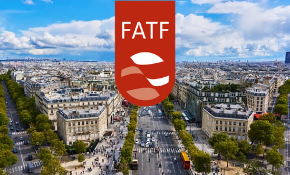Update Date: December 2022
What is The BSA AML Index?
In recent years, money laundering has been rapidly growing. So the amount of dirty money. Governments and financial institutions try to protect themselves from this crime.
Read on to learn about the
Basel 2022 Index
and the
Country's risk scores
.
Basel Institute of Governance is an independent, international, non-profit organization committed to preventing Corruptionuption and other financial crimes. The organization was established in Basel, Switzerland.
Each year, Basel prepares an independent score and ranking that assesses the world's risk of money laundering and terrorist financing. This ranking is the Basel AML Index. Published by the Basel Institute of Governance since 2012, this document gives risk scores based on data from 15 publicly available sources such as the Financial Action Task Force (FATF) , the World Bank, and the World Economic Forum. FATF country's risk scores cover five areas:
- Quality of AML / CFT framework
- BriberCorruptionuption
- Financial transparency and standards
- Public transparency and accountability
- Legal and Political Risks
The primary objective is not to rank countries superficially compared to each other but to give an overall view of different countries 'and regions' risk levels and their progress in addressing vulnerabilities over time.
Scores and Rankig
The Top 10 Countries With the Highest AML Risk
|
JURISDICTION
|
OVERALL SCORE
|
|
Finland
|
2.88
|
|
Andorra
|
2.89
|
|
Sweden
|
3.12
|
|
Iceland
|
3.31
|
|
New Zealand
|
3.32
|
|
San Marino
|
3.34
|
|
Slovenia
|
3.37
|
|
Lithuania
|
3.43
|
|
Norway
|
3.50
|
|
France
|
3.52
|
The Top 10 Countries With the Lowest AML Risk
|
JURISDICTION
|
OVERALL SCORE
|
|
The Democratic Republic Of The Congo
|
8.30
|
|
Haiti
|
8.16
|
|
Myanmar
|
7.78
|
|
Mozambique
|
7.68
|
|
Madagascar
|
7.59
|
|
Guinea-Bissau
|
7.53
|
|
Cambodia
|
7.36
|
|
Mali
|
7.28
|
|
Senegal
|
7.05
|
|
Vietnam
|
7.04
|
Regional Focus
The Basel AML Index follows the World Bank classification of countries, with an additional separation of Europe and Central Asia into two regions:
- European Union and Western Europe
- Europe and Central Asia
- East Asia and Pacific
- Latin America and the Caribbean
- The Middle East and North Africa
- North America
- South Asia
- Sub-Saharan Africa
Learn Anti-Money Laundering Requirements of your country!
1. European Union and Western Europe
ML/TF risk levels improved from last year as country coverage increased from 24 to 31 jurisdictions with the new FATF assessments of Bulgaria, Croatia, France, Germany, Liechtenstein, Netherlands, and Poland.
- The overall risk score is 997
- The quality of the AML / CFT framework is 4.45
- Bribery and corruption 2.91
- Financial transparency and standards 3.71
- Public transparency and accountability 2.70
- Legal and political risk 2.79
|
JURISDICTION
|
OVERALL SCORE
|
|
Finland
|
2.88
|
|
Andorra
|
2.89
|
|
Sweden
|
3.12
|
|
Iceland
|
3.31
|
|
San Marino
|
3.34
|
|
Slovenia
|
3.37
|
|
Lithuania
|
3.43
|
|
Norway
|
3.50
|
|
France
|
3.52
|
|
Denmark
|
3.56
|
|
United Kingdom
|
3.63
|
|
Greece
|
3.71
|
|
Czech Republic
|
3.81
|
|
Spain
|
3.88
|
|
Latvia
|
3.96
|
|
Portugal
|
4.00
|
|
Ireland
|
4.00
|
|
Belgium
|
4.01
|
|
Austria
|
4.01
|
|
Netherlands
|
4.06
|
|
Germany
|
4.21
|
|
Slovakia
|
4.35
|
|
Poland
|
4.39
|
|
Switzerland
|
4.55
|
|
Italy
|
4.55
|
|
Liechtenstein
|
4.59
|
|
Cyprus
|
4.61
|
|
Croatia
|
4.74
|
|
Malta
|
4.83
|
|
Hungary
|
4.98
|
|
Bulgaria
|
5.16
|
2.Europe and Central Asia
The weakest areas of the region are political and legal risks, corruption, and bribery.
- The overall risk score is 5.15
- The quality of the AML / CFT framework is 5.08
- Bribery and corruption 5.88
- Financial transparency and standards 5.16
- Public transparency and accountability 3.49
- Legal and political risk 5.69
|
JURISDICTION
|
OVERALL SCORE
|
|
Georgia
|
4.64
|
|
Armenia
|
4.64
|
|
Moldova
|
4.70
|
|
Serbia
|
4.87
|
|
Albania
|
4.92
|
|
Ukraine
|
5.09
|
|
Uzbekistan
|
5.20
|
|
Belarus
|
5.21
|
|
Russia
|
5.24
|
|
Turkey
|
5.54
|
|
Tajikistan
|
5.83
|
|
Kyrgyzstan
|
5.92
|
It is not reflected in the indicators used by the Basel AML Index and therefore did not affect Russia's overall risk score.
3.East Asia and Pacific
The East Asia and Pacific region risk scores are slightly higher than the global average. The region has risks related to Corruption/bribery, human trafficking, public and financial transparency, and political/legal systems and has significant overall risk scores.
- The overall risk score is 5.48
- The quality of the AML / CFT framework is 6.08
- Bribery and corruption 4.22
- Financial transparency and standards 4.96
- Public transparency and accountability 4.40
- Legal and political risk 3.68
|
JURISDICTION
|
OVERALL SCORE
|
|
New Zealand
|
3.32
|
|
Australia
|
3.53
|
|
Taiwan
|
3.75
|
|
Singapore
|
4.28
|
|
South Korea
|
4.51
|
|
Fiji
|
4.65
|
|
Japan
|
4.70
|
|
Samoa
|
4.89
|
|
Indonesia
|
5.19
|
|
Vanuatu
|
5.26
|
|
Malaysia
|
5.33
|
|
Philippines
|
5.68
|
|
Palau
|
5.71
|
|
Thailand
|
5.80
|
|
Mongolia
|
5.86
|
|
Solomon Islands
|
6.54
|
|
China
|
6.69
|
|
Tonga
|
6.72
|
|
Vietnam
|
7.04
|
|
Cambodia
|
7.36
|
|
Myanmar
|
7.78
|
The weakest area is the quality of AML/CFT frameworks. New Zealand retains the top place as the lowest risk country, despite an increased risk score following a new FATF evaluation. There are high trafficking risks in China, Malaysia, and Myanmar.
4.Latin America and the Caribbean
Most of the countries are within the medium-risk category.
- The overall risk score is 5.34
- The quality of the AML / CFT framework is 5.51
- Bribery and corruption 5.06
- Financial transparency and standards 5.55
- Public transparency and accountability 4.66
- Legal and political risk 4.57
|
JURISDICTION
|
OVERALL SCORE
|
|
Chile
|
4.03
|
|
Uruguay
|
4.07
|
|
Costa Rica
|
4.58
|
|
Peru
|
4.72
|
|
Colombia
|
4.74
|
|
Trinidad and Tobago
|
4.86
|
|
Grenada
|
4.91
|
|
Antigua and Barbuda
|
4.98
|
|
Aruba
|
4.99
|
|
Dominican Republic
|
5.03
|
|
Mexico
|
5.20
|
|
Guatemala
|
5.29
|
|
Jamaica
|
5.37
|
|
Barbados
|
5.38
|
|
Saint Lucia
|
5.42
|
|
Honduras
|
5.54
|
|
Cuba
|
5.62
|
|
Panama
|
5.81
|
|
Bahamas
|
5.93
|
|
Saint Kitts and Nevis
|
6.06
|
|
Nicaragua
|
6.70
|
|
Haiti
|
8.16
|
90% of the assessed territories are listed as “money laundering jurisdictions” by the US. There are significant differences across the region, indicating different institutional capacities to mitigate risks.
5.The Middle East and North Africa
- The overall risk score is 5.03
- The quality of the AML / CFT framework is 5.76
- Bribery and corruption 4.70
- Financial transparency and standards 4.72
- Public transparency and accountability 4.12
- Legal and political risk 4.15
|
JURISDICTION
|
OVERALL SCORE
|
|
Israel
|
3.63
|
|
Bahrain
|
4.83
|
|
Malta
|
4.83
|
|
Egypt
|
4.84
|
|
Tunisia
|
4.89
|
|
Jordan
|
5.07
|
|
Morocco
|
5.16
|
|
Saudi Arabia
|
5.28
|
|
United Arab Emirates
|
5.70
|
6.North America
The effectiveness of measures for beneficial ownership transparency remains a critical concern in the region.
- The overall risk score is 4.23
- The quality of the AML / CFT framework is 5.23
- Bribery and corruption 2.55
- Financial transparency and standards 2.72
- Public transparency and accountability 2.53
- Legal and political risk 2.31
|
JURISDICTION
|
OVERALL SCORE
|
|
Canada
|
4.25
|
|
United States
|
4.32
|
7.South Asia
Beneficial ownership, prevention, prosecutions, and confiscation are all weak spots in terms of effectiveness in the region.
- The overall risk score is 6.02
- The quality of the AML / CFT framework is 6.36
- Bribery Corruption 5.75
- Financial transparency and standards 5.65
- Public transparency and accountability 4.68
- Legal and political risk 5.12
|
JURISDICTION
|
OVERALL SCORE
|
|
Bangladesh
|
5.75
|
|
Sri Lanka
|
6.01
|
|
Bhutan
|
6.15
|
|
Pakistan
|
6.16
|
8.Sub-Saharan Africa
Nearly 62% of countries in this region are assessed as having a high risk of ML/TF.
- The overall risk score is 6.58
- The quality of the AML / CFT framework is 7.05
- Bribery and corruption 5.96
- Financial transparency and standards 6.08
- Public transparency and accountability 5.21
- Legal and political risk 5.34
|
JURISDICTION
|
OVERALL SCORE
|
|
Mauritius
|
5.03
|
|
Botswana
|
5.07
|
|
Seychelles
|
5.49
|
|
Mauritius
|
5.32
|
|
Malawi
|
5.62 |
|
Ghana
|
5.70
|
|
South Africa
|
5.81
|
|
Zambia
|
5.99
|
|
Cape Verde
|
6.11
|
|
Tanzania
|
6.33
|
|
Niger
|
6.60
|
|
Burkina Faso
|
6.63
|
|
Ethiopia
|
6.63
|
|
Zimbabwe
|
6.70
|
|
Nigeria
|
6.77
|
|
Benin
|
6.80
|
|
Uganda
|
6.82
|
|
Cameroon
|
6.88
|
|
Mauritania
|
6.89
|
|
Eswatini
|
6.91
|
|
Sierra Leone
|
6.97
|
|
Senegal
|
7.05
|
|
Mali
|
7.28
|
|
Guinea-Bissau
|
7.53
|
|
Madagascar
|
7.59
|
|
Mozambique
|
7.68
|
|
The Democratic Republic Of The Congo
|
8.30
|
What Is Wrong, And What Can Be Done To Improve Supervision Generally?
Supervision is very much at the intersection between regulation and implementation, for example, technical compliance with AML/CFT standards and their enforcement. Looking at data from recent FATF reports, we see that while countries generally have low or mediocre scores for technical compliance, the most problematic issue is the effectiveness of their measures.





